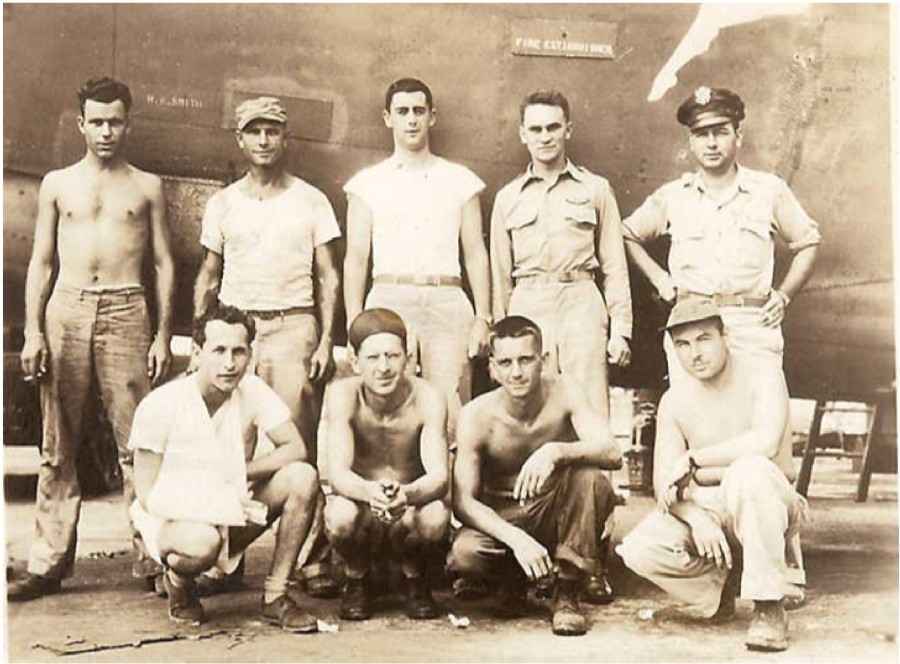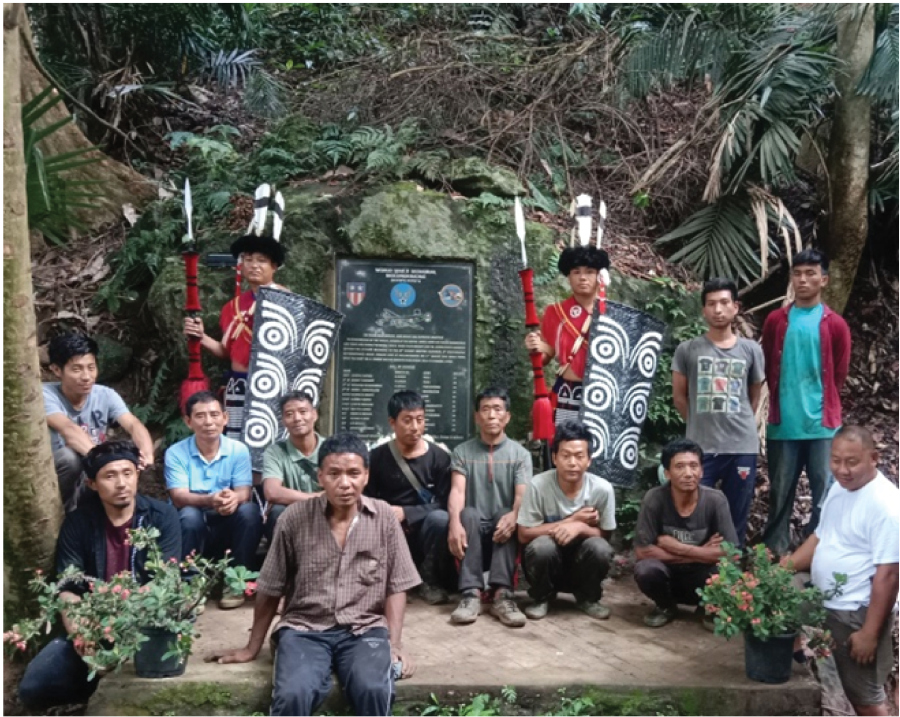
Crew of F-7A Liberator 42-64189 in front of the aircraft

Molungkimong villagers conducting memorial service at the crash site on the crash anniversary on 11 August 2023
Talimeren Tzudir
Retd. Petty Officer, Indian Navy
The June 9 edition of The Hindu carried an interesting headline, "US Consul General seeks govt. help to locate remains of American soldiers killed in Assam in World War II". It covered the news of the US Consul General at Kolkata, Melinda Pavek, calling on the CM and Governor of Assam to discuss collaboration in various areas such as health, agriculture, and economic development. What stood out was the Consul General seeking help from the Assam government in locating the remains of nearly 1000 American soldiers who died while serving in Northeast India during WWII. It revived the harrowing and lesser-known history of WWII in this region that resulted in thousands of American casualties, many of whose remains stay unaccounted to this day. To understand the presence of American soldiers in this part of the world during WWII, one needs to understand the historical background of the war beyond the more prominent Battle of Kohima.
WWII was a global conflict that reshaped the course of history. While the main Theaters of the war like Europe and the Pacific often take center stage in historical narratives, the contribution of other regions, such as Northeast India, is largely overlooked. This region fell under the China Burma India (CBI) Theater dubbed as 'The Forgotten Theater' of WWII due to the Allied leadership's 'Europe first' strategy. With a scanty allotment of resources and less press coverage as compared to the European and Pacific Theaters, the CBI Theater of WWII was a strategically vital region that spanned across China, Burma (now Myanmar), and India. Here, the American troops played a significant role in the overall war effort against Japanese expansion in the Asia-Pacific. The Theater's main objectives included keeping China in the fight against the Japanese by maintaining supply lines to China, supporting Chinese resistance against Japan, and securing the region's access to vital resources. Consequently, 1.25 million Japanese troops remained tied down in China which would otherwise have been fighting the Allied forces somewhere in the Pacific. Key elements of the CBI Theater concerning Northeast India include the Hump Airlift operation (also known as the China-Burma-India Airlift), which involved airlifting supplies over the treacherous Himalayas (referred to as 'the Hump') from airfields in Assam to China; the construction of the Ledo Road (Stilwell Road), which connected India to China through Burma and helped alleviate logistical challenges; and the diverse range of military operations, from the Burma Campaign to counter Japanese advances in Southeast Asia including the battles of Kohima and Imphal.
The Hump Airlift operation accounts for most of the American casualties in Northeast India. The operation was a colossal effort to supply Chinese and American forces with vital resources, bypassing Japanese-controlled land and sea routes. It was a logistical marvel and the US Air Force called it the first and the largest strategic airlift before the Berlin airlift with over 650000 tons of supplies and men flown over the Himalayan mountain range in over 42 months with a plane crossing the Hump every minute and twelve seconds at the peak of operation. Airfields such as Jorhat, Chabua, Dinjan, and Mohanbari in Assam became pivotal points where aircraft were loaded with supplies before embarking on the perilous journey across the Himalayas to China. Assam's proximity to the Burma front and its access to India's extensive rail and road networks made it an ideal base for these operations. "Every vehicle, every gallon of fuel, every weapon, every round of ammunition, every typewriter and every ream of paper which found its way to Free China for either the Chinese or the American forces during nearly three years of war was flown in by air from India," the official US Army Air Forces history of the war said.
Challenges in the Hump flight were numerous. The towering peaks of the Himalayas posed serious threats to aircraft, and the weather on the Hump was notoriously volatile with sudden shifts from clear skies to blizzards. The thin air at high altitudes reduced the aircraft's carrying capacity, making each trip a calculated risk. In addition, the planes often faced attacks from Japanese fighter planes and anti-aircraft fire. With one of the worst wartime survival rates ever, the airlift was achieved at the cost of over 1600 airmen in over 700 plane crashes. "Every 340 tons delivered cost the life of a pilot," writes historian Francis Pike in his book, Hirohito's War: The Pacific War, 1941-1945. The 500-mile Hump route was eventually known as 'The Aluminum Trail' for all the aluminum from the crashed planes that were scattered along the route. Many of the crash sites have not been located yet and the remains of many airmen stay unaccounted till date.
While many of the crashes happened in Assam, Arunachal Pradesh, Myanmar, and China, there are numerous crash sites in Nagaland too. One such incident was the crash of a United States Army Air Forces (USAAF) F-7A Liberator in Molungkimong village of Mokokchung district on 11 August 1944, where 12 airmen died. The aircraft numbered 42-64189 was a reconnaissance plane of the 24th Combat Mapping Squadron that was responsible for conducting aerial mapping and reconnaissance missions using specialized photographic equipment to capture vital intelligence and terrain data. The ill-fated plane, piloted by 24-year-old 1st Lt James T Caraway, was on a combat and cargo mission from Jorhat to Kunming, China. Like many of the planes that crashed in the Hump operation, the cause is unknown. Surviving eyewitnesses recount hearing the sound of a plane approaching the village on a rainy August day. They heard an explosion in the sky and saw the disintegrating plane descend below the clouds sending down burning fuel and debris into the village. Crossing the village, it crashed into a ravine a couple of kilometers away from the village with a big explosion. The impact resulted in a series of explosions apparently due to the gasoline and ammunition it was carrying. Luckily, the rain prevented the fire from spreading in the village as well as the crash site. When the fire died down, the men folks of the village went to look for survivors but there was none. However, they found and laid to rest four deceased individuals in a mass Christian burial at the crash site. Two weeks later, an American search and rescue party that arrived at the village, exhumed and took the bodies for cremation in the military cemetery in Jorhat. After 76 years, when details of the crash were finally unraveled through research in 2020, the Molungkimong Village Council immediately erected a memorial plaque at the crash site to honour the deceased soldiers. It came as a fitting tribute for the martyrs and a closure for some of the victims' relatives who had given up hopes of knowing where and how their loved ones had died. Once a forgotten history, the villagers commemorate the crew every year on the day of the crash by conducting a memorial service at the crash site. Recognizing the importance of preserving history, the Village Council also opened a museum at the center of the village in December 2022, where they have put on display pictures and stories of the 12 aircrews, the aircraft parts, and a scale model replica of the aircraft. Sadly, for the other crashes in Nagaland, not much is known about the planes or the occupants. What remains are just some metal scraps and dissipating stories.
The success of the CBI Theater in general and the Hump Airlift operation, in particular, would not have been possible without the dedicated help of the people of Northeast India, Burma, and China. The local population played an essential role in construction, maintenance, and support activities. There are also many instances where locals rescued American airmen who bailed out into the jungles before a crashand escorted them safely to the nearest US military bases in Assam. Northeast India's integral role in this operation, from serving as a logistical hub to providing invaluable support, demonstrates the region's contribution to the global effort during WWII. The overall contributions of the locals in terms of labour, hospitality, and cooperation were instrumental in transforming the region into a bustling center of Allied operations.
While it is never too late for the US government to repatriate the remains of their soldiers who sacrificed their lives in distant lands, it is also a moment for us to reflect on our history and acknowledge the invaluable role our humble ancestors played in the war. This, in turn, helps us grasp a deeper sense of our identity.




